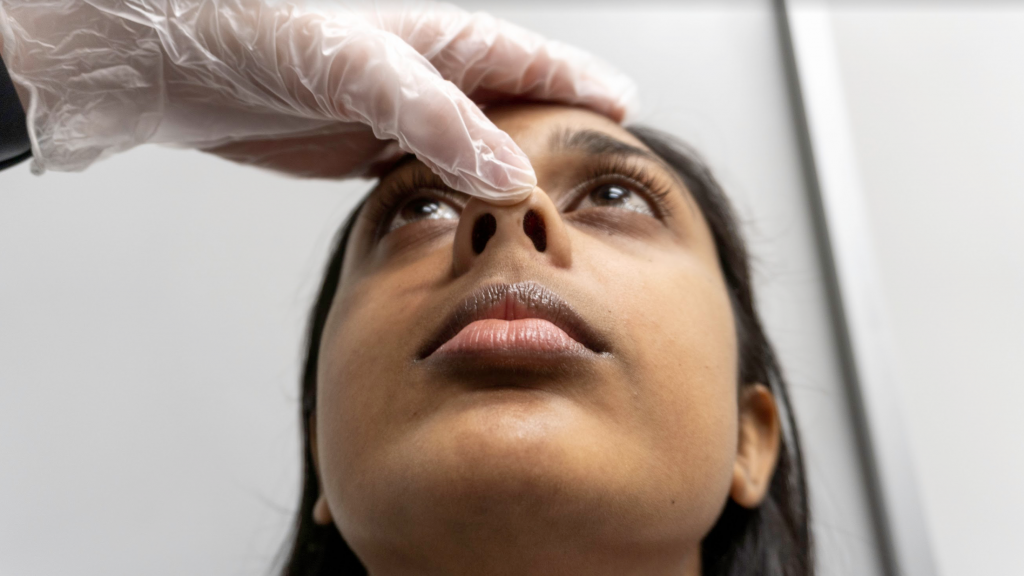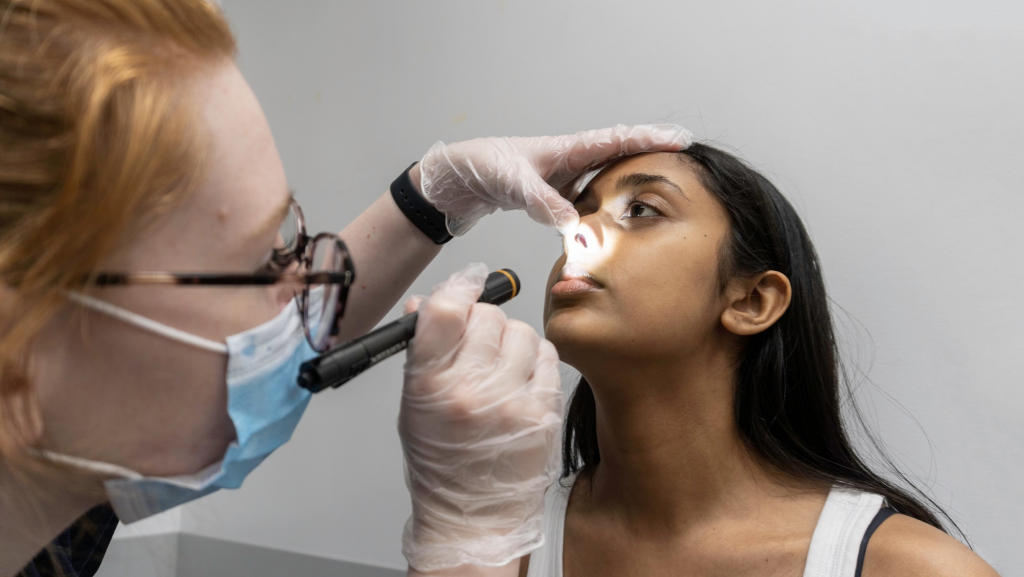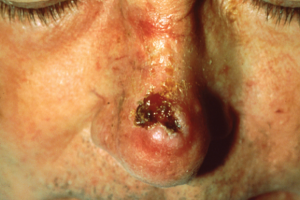Chapter 3 – Respiratory System Assessment
Nose and Sinuses
Inspection and palpation of the nose should be performed standing directly in front of the client while they are sitting upright on the examination table or a chair. It is important to don gloves as you may be in contact with bodily fluids such as nasal discharge.
Inspection
Steps to inspect the nose include:
- Inspect the external surface of the nose for colour.
- Normally, the nose is the same colour as the rest of the face with no discolourations such as redness. Describe the appearance and location of any discolourations noted.
- Inspect the contour and external surface of the nose for symmetry, swelling, and malformations such as masses and lesions.
- Normally, the nose is symmetrical with no swelling or malformations. Describe the appearance and location of any abnormalities.
- Inspect the nasal cavity and mucosa of the nose for colour, discharge/bleeding, swelling, foreign bodies, and malformations, and inspect septum. See Figure 3.8 and Video 3.4.
- Ask the client to tilt their head gently backwards while you use your finger to elevate the tip of their nose.
- Use a penlight or the light source from a otoscope to illuminate the nasal cavity. Use a large/wide cover for the otoscope probe and ensure that you do not touch any part of the nose with it as the mucosa is sensitive and highly vascular. Discard the probe cover in the garbage when done.
- The nasal mucosa is normally pinkish red in colour with no discharge or bleeding. Describe any discolouration of the mucosa or the colour and amount of any discharge/bleeding.
- Normally, there is no swelling or foreign bodies. If present, describe the appearance and location of swelling and foreign bodies. In children, common foreign bodies include little toys and beads.
- Normally, the septum is midline, intact with no perforations.
- Common malformations may include lesions, masses, polyps, and deviated or perforated septum. If any are present, describe the appearance and location. Polyps appear as a tear-drop formation. A deviated septum is when the septum is off centre and bulges laterally. A perforated septum is when there is a hole/opening in the septum; it is typically observed when you illuminate one side of the nasal cavity and you observe the light on the other side.


Figure 3.8: Inspecting the nasal cavity and mucosa
4. Note findings:
-
- Normal findings might be documented as: “External nose is symmetrical with no discolouration, swelling or malformations. Nasal mucosa is pinkish red with no discharge/bleeding, swelling, malformations or foreign bodies.”
- Abnormal findings might be documented as: “Bright red nasal mucosa with purulent discharge.”
Video 3.4: Inspecting the nasal cavity and mucosa
Palpation
Steps to palpate the nose and sinuses include:
- With your thumb, gently palpate one sinus at a time.
- Use a circular motion to palpate.
- Begin with the frontal sinuses inferior to the eye brows over the bony ridge. Avoid the eye socket.
- Then, palpate the maxillary sinuses inferior to the zygomatic bone slightly lateral to the nose.
- Inquire if the client had any pain/tenderness upon palpation. A slight pressure is normal. If pain/tenderness is present, assess further subjectively.
- Palpate the nose for airflow/patency.
- Occlude one naris at a time while placing your index finger over the outside of the nose/nasal wing.
- Ask the client to take a deep and quick inhalation in through the nose (like a sniff in which they draw air inwards as if trying to smell something).
- Note the client’s capacity to breathe inwards. The client should be able to breathe inwards with no obstructions.
- Gently palpate the external nose if trauma/injury or lesions are present.
- Use the thumb and the index finger to palpate the contour.
- Lesions can be palpated with the index finger and note the consistency of lesions (e.g., are they soft or firm?).
- Note the findings:
- Normal findings might be documented as: “No sinus pain noted. Nose is patent with good air flow.”
- Abnormal findings might be documented as: “Left frontal sinus pain 6/10.”
Priorities of Care
You should call for assistance while monitoring breathing and vital signs and performing a focused assessment if the client is experiencing signs of respiratory distress associated with any malformations, trauma/injury to the nose, or nasal obstructions. It can be helpful to sit the client upright to assist with breathing.
Deviated septum is quite common. Unless it affects a client’s breathing, typically no action is required. Similarly, if a client has a nasal obstruction or an absence of sniff, you should attempt to determine the cause. Is it mucous or a foreign body (like a toy)? Does it just affect one side? If an obstruction is noted, assess for the presence of any findings of respiratory distress. Usually absence of sniff in one naris isn’t an urgent finding as a person can breathe through the other side and the mouth, but you should evaluate the cause.
Other abnormal findings that require action are lesions and sinus pain. A focused assessment should be performed and findings reported to the physician/nurse practitioner. Depending on the cause, sinus pain may require treatment such as decongestants, antibiotics, or antihistamines. Cutaneous lesions on the nose should be closely examined. There are many causes of lesions such as herpes simplex virus or a melanoma. For example, the lesion in Figure 3.9 is a carcinoma, which is a serious finding. These sorts of lesions are often brought to the attention of healthcare providers when clients share that they have noticed an open sore that has developed with no physical trauma and has not healed. In addition to no physical trauma, a sore that doesn’t heal should be of concern; although it really depends on the type and severity of a sore, the typical timeframe to heal is 4 to 6 weeks. These lesions are not a critical finding, but they are life-threatening; they require prompt intervention because they are curable if diagnosed and treated early.

Figure 3.9: Squamous cell carcinoma lesion
(Image from the National Cancer Institute: https://visualsonline.cancer.gov/details.cfm?imageid=2165)
Activity: Check Your Understanding

